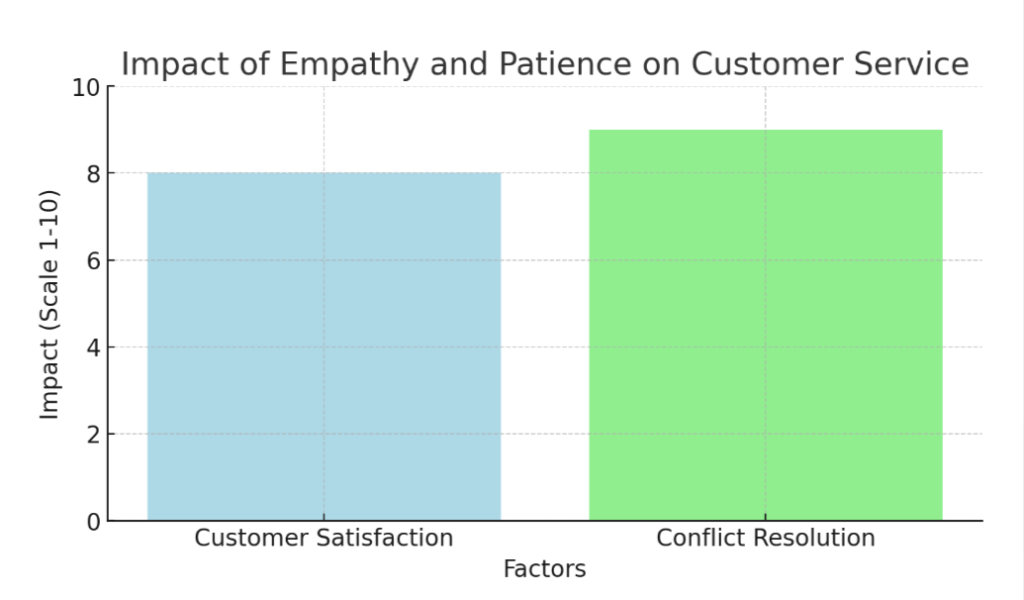Cultivating Key Virtues: Empathy and Patience in Customer Service
Customers often feel unheard and frustrated when seeking help. A key fact to remember is that empathy and patience can transform a service experience from poor to exceptional. This article provides actionable steps for customer service professionals to master these crucial skills.
Keep reading, it’s game-changing!
Key Takeaways
- Empathy in customer service is about understanding and sharing the feelings of customers. Representatives should listen actively, acknowledge emotions and use positive language to make genuine connections.
- To develop empathy, it’s beneficial for service teams to undergo training that includes role – playing scenarios where they can practice empathetic responses and learn to manage their biases.
- Using empathy statements across all forms of communication such as phone calls and emails helps create a personalized experience for each customer, making them feel valued and understood.
- Active listening skills are vital in providing solutions that align with what’s important to the customer, helping to resolve concerns effectively which leads to higher customer satisfaction.
- Empathy has the power to diffuse conflicts by creating a supportive environment where customers’ perspectives are respected leading to stronger relationships and trust between customers and businesses.
The Importance of Empathy and Patience in Customer Service
Understanding the customer’s perspective and actively listening are crucial in providing empathetic and patient customer service. Overcoming biases and using positive language can help create a genuine connection with customers.
Understanding the customer’s perspective
Seeing things from the customer’s point of view is essential in delivering service excellence. It means stepping into their shoes to grasp what they are going through, why they might be frustrated, or what kind of solution would truly help them.
This approach not only shows compassion but also sheds light on understanding customer needs more deeply.
Active listening plays a key role here; it involves paying full attention and engaging with the individual without jumping to conclusions. By doing so, you create an emotional bond that can transform a simple interaction into a personalized customer experience.
These strong connections foster loyalty and trust which are fundamental for building rapport and long-lasting customer relations. Next, we’ll explore how overcoming biases enhances our ability to listen actively and empathize effectively.
Overcoming biases and actively listening
Overcoming biases requires customer service representatives to recognize their own preconceived notions and approach each interaction with an open mind. This means setting aside personal judgments, focusing on the customer’s needs, and treating every individual with equal respect and attention.
Active listening goes hand in hand with this process; it involves paying close attention to what the customer is saying without interrupting or formulating a response while they are speaking.
It’s essential for understanding the root of their concerns.
Service excellence depends on the ability to hear beyond words—observing tone, pace, and emotion—to truly grasp the situation from the customer’s perspective. Building rapport becomes easier when customers feel heard and understood rather than judged or dismissed.
Active listening skills enable representatives to pick up on subtle cues that can guide them in providing personalized support and solutions tailored to each unique case. Empathy phrases for customer service like “I understand why that would be frustrating” or “That sounds challenging” validate feelings, creating a genuine human connection that fosters emotional bonds with customers.
Using positive language and creating a genuine connection
Positive language transforms customer interactions into opportunities for building rapport and displaying empathy. It starts with simple word choices that convey understanding and compassion, like saying “I see what you mean” instead of “I don’t disagree.” This approach supports a personalized customer experience where clients feel their emotions are valid and their concerns matter.
By consistently using affirming words, service representatives create emotional bonds that leave customers feeling heard and respected.
Creating a genuine connection goes beyond scripted responses to showing real interest in the person’s situation. Empathy phrases for customer service come to life when infused with sincerity; it’s not just about solving problems but also acknowledging the person behind them.
A supportive communication style, coupled with active listening skills, fosters an environment where customers know they’re valued as individuals, not just ticket numbers or issues to be resolved.
As this bond strengthens, so does the overall customer satisfaction—a clear sign of service excellence in action. Next up is exploring practical empathy statements that can further enhance these connections.
Empathy Statements and Phrases for Customer Service
Empathy statements and phrases are vital for acknowledging customer feelings, uncovering their needs, providing suggestions, and making them feel appreciated. Using these phrases in customer service can lead to building a genuine human connection and improving the overall customer experience.
Acknowledging feelings and concerns
When addressing customer concerns, it’s crucial to acknowledge their feelings and emotions. This shows that you understand and care about their experience, which can help in building a positive rapport with the customer.
By using phrases like “I understand how frustrating that must be” or “I appreciate you sharing your concerns,” you demonstrate empathy and validate the customer’s emotions, making them feel heard and valued.
Moreover, acknowledging feelings and concerns creates an opportunity to address specific issues effectively. It sets the stage for providing personalized solutions and ensuring customers feel supported throughout their interaction with your business.
Uncovering what’s important to the customer
As you acknowledge customers’ feelings and concerns, it’s essential to dig deeper and uncover what truly matters to them. Understanding the unique needs and priorities of each customer allows for a more personalized and empathetic approach.
By actively listening and asking relevant questions, you can gain insight into their preferences, values, and goals. This understanding empowers you to tailor your support in a way that resonates with the customer on a personal level, ultimately fostering stronger relationships and enhancing the overall customer experience.
Providing suggestions and maintaining positivity
When providing suggestions, it’s essential to maintain a positive and supportive tone. This can be achieved by offering constructive solutions that align with the customer’s needs and preferences.
Ensuring that your language is encouraging and solution-oriented can help in maintaining positivity during interactions with customers.
Maintaining a positive attitude when suggesting options or alternatives demonstrates empathy, understanding, and a commitment to finding the best resolution for the customer’s concerns.
Making customers feel appreciated
Customers feeling appreciated is crucial for building rapport and fostering long-term relationships. Using personalized empathy statements can make customers feel valued and understood.
Acknowledging their feelings, providing positive suggestions, and maintaining a supportive communication style can create an emotional bond with the customer, leading to enhanced satisfaction and loyalty.
Ensuring that your customer feels appreciated involves making genuine connections by actively listening to their concerns. Employing empathy phrases in various forms of communication such as over the phone or through written correspondence can leave a lasting impact on the customer’s experience.
Techniques for Developing Empathy and Patience
To develop empathy and patience in customer service, it’s important to focus on active listening, recognize and manage biases, provide training in empathy, and engage in role-playing scenarios to practice empathetic responses.
These techniques can help customer service professionals better understand and connect with their customers on a deeper level.
Focus on listening
Listen actively and attentively to your customers’ concerns, thoughts, and emotions. Avoid interrupting or formulating a response while the customer is speaking. Provide verbal cues such as “I see,” “Go on,” to show that you are engaged in the conversation.
Maintaining eye contact and nodding are also effective ways to demonstrate your attentiveness.
Ensure that you fully comprehend what the customer is expressing by paraphrasing their statements back to them. This not only confirms that you understand but also reassures the customer that they have been heard.
Recognize and manage biases
In addition to focusing on listening, recognizing and managing biases is crucial in developing empathy and patience in customer service. Biases can influence how we perceive and interact with customers, affecting our ability to understand their perspective and provide empathetic support.
By acknowledging and addressing biases, customer service professionals can create a more inclusive and supportive environment for all customers, fostering stronger relationships and improving overall satisfaction.
Through ongoing awareness and active management of biases, customer service teams can cultivate a culture of empathy that positively impacts the customer experience.
Training in empathy
To develop empathy, customer service representatives can undergo specialized training to enhance their emotional intelligence. This can involve workshops and courses that focus on understanding and connecting with customers on a deeper level.
Role-playing scenarios can help employees practice responding empathetically in various situations, while receiving constructive feedback from trainers or peers. Additionally, providing ongoing support and resources for staff to further develop their empathy skills is crucial in creating a customer-centric culture within the organization.
Acquiring empathy skills through training helps customer service representatives approach interactions with understanding and compassion, leading to more positive experiences for both customers and employees alike.
Role-playing empathy scenarios
Role-playing empathy scenarios allows customer service representatives to step into the shoes of customers and understand their needs better. By simulating common customer interactions, employees can practice active listening, acknowledging feelings, and offering appropriate responses.
This exercise helps in developing a deeper sense of empathy and patience towards various customer concerns, ultimately enhancing the overall quality of service provided.
Engaging in role-playing empathy scenarios also enables team members to recognize biases and assumptions that may affect their ability to empathize with customers effectively. Through these interactive sessions, employees can learn to respond with compassion while addressing challenges that contribute to building genuine connections with customers.
Tips for Utilizing Empathy and Patience in Customer Service
Utilize empathy statements in various forms of communication to build better conversations and create a personalized customer experience. Interested in learning more about developing empathy and patience in customer service? Keep reading to discover the impact of empathy on customer satisfaction and how it can help diffuse conflicts effectively.
Building better conversations
Engage customers in meaningful dialogue by asking open-ended questions and actively listening to their responses. Encourage them to share their experiences and concerns, showing genuine interest in understanding their perspective.
Use empathy statements and phrases from the training to convey compassion and support, creating an emotional bond with the customer.
Empower your team with communication skills that foster better connections, leading to improved customer satisfaction. Developing empathy and patience will positively impact customer relations while enhancing the overall experience.
Using empathy statements in various forms of communication
Implement empathy statements in all forms of communication, such as emails, phone calls, and face-to-face interactions. Tailor your language to acknowledge the customer’s feelings and concerns.
Offer genuine support by utilizing phrases that express understanding and compassion. Ensure that your tone is positive and empathetic when suggesting solutions or providing assistance to customers.
Through these methods, you can create a personalized experience for each customer, making them feel valued and appreciated.
The impact of empathy on customer satisfaction
Empathy plays a vital role in boosting customer satisfaction. When customer service representatives demonstrate understanding, compassion, and active listening skills, it creates an emotional bond with customers.
Customers feel valued and heard when their concerns are acknowledged and addressed with empathy. This genuine human connection leads to increased customer satisfaction, as they perceive the company as caring about their needs and well-being.
Active listening skills enable employees to uncover what’s important to the customer, leading to personalized support that aligns with their specific requirements. Additionally, when conflicts arise, the power of empathy diffuses tension and fosters positive resolutions, further enhancing overall customer satisfaction levels.

The power of empathy in diffusing conflicts
Transitioning from understanding the impact of empathy on customer satisfaction to the power of empathy in diffusing conflicts, it becomes evident that empathetic interactions play a pivotal role in resolving challenging situations.
By actively listening and acknowledging customer concerns, service professionals can de-escalate tensions and establish a supportive environment. Understanding the emotional perspective of customers allows for personalized problem-solving and empowers agents to offer tailored solutions that address underlying issues.
Through compassionate communication and genuine human connection, conflicts are diffused effectively, leading to improved customer satisfaction and strengthened relationships.
Conclusion
In conclusion, developing empathy and patience in customer service is crucial for building genuine connections with customers. Active listening skills and using empathetic phrases can help in understanding their concerns.
By recognizing biases and providing a personalized experience, customer service representatives can effectively diffuse conflicts and enhance overall satisfaction. Empathy and patience are not just buzzwords – they are essential tools for creating meaningful interactions that foster loyalty and trust.

